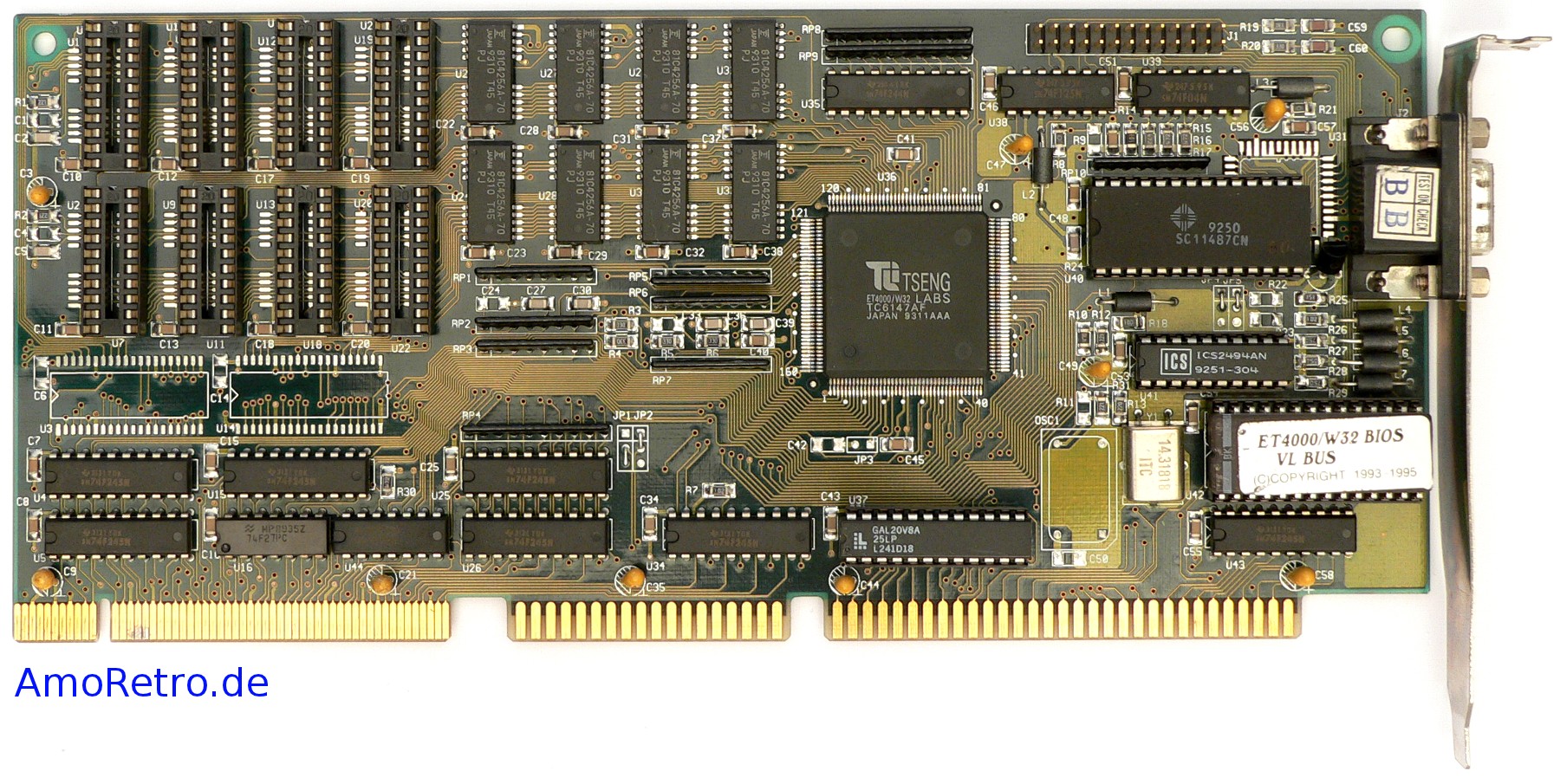 Tseng Labs, Inc.
Tseng Labs, Inc.
Tseng Labs was a graphics card and chipset manufacturer for the IBM PC and its compatibles from 1983 to December 1997.
Tseng Labs, Inc. was founded in 1983 to develop and produce video enhancement products for the IBM-compatible personal computer industry. These products consisted of custom-designed Application Specific Integrated Circuits (ASICs), or video controller chips, and OEM video controller adapters.
Tseng Labs entered the PC video controller market with the UltraPAK monochrome adapter. The UltraPAK enhanced the first video standard IBM created by producing text resolutions of up to 132x44, supporting graphic emulation modes, and performing multi-function capabilities with expanded system memory and parallel/serial port options. As late as 1997, this adapter was still in use in institutions where terminal emulation requirements were strong, such as hospitals and other institutions.
In 1984, the UltraPAK-S was introduced. The UltraPAK-S lowered the price of monochrome technology by offering a board designed after the successful ET1000-based UltraPAK without multi-function capabilities. Tseng then responded to IBM's 1985 introduction of the Enhanced Graphics Adapter standard with the ET2000 chip set, which yielded the 1986 introduction of the EVA and EVA/480 graphics adapters. These EGA-compatible adapters improved upon the EGA standard by combining 100 percent IBM compatibility, UltraPAK-pioneered terminal emulation, and beyond-EGA resolution of 640x480--more powerful than any EGA-compatible controller of its era.
Late 1987 saw the initial shipment of the ET3000 ASIC, which combined 100 percent register-level compatibility with IBM PS/2 hardware/software and included all the features of the ET2000 chip set on a single ASIC chip. The ET3000 marked the exclusive entry by Tseng into the OEM video market, and marked the end of its retail video adapter involvement. The ET3000 chip provided the now-traditional enhancements over IBM's video standard, this time VGA, with resolution up to 1024x768.
They were best-known for the Tseng Labs ET3000, Tseng Labs ET4000 and Tseng Labs ET6000 VGA-compatible graphics chips, which were highly popular between 1990 and 1995 (the era of Windows 3.x). The company's ET4000 family was noteworthy for its unusually fast host interface (ISA) throughput, despite having a conventional DRAM framebuffer.
Tseng moved from being a retail / commercial board supplier to OEM seller of their graphics chips. Ultimately, Tseng Labs' VGA controllers were found in PCs from major system and board companies including Compaq, CompuAdd, Dell, IBM, NEC, Sigma Designs, STB Systems, Diamond Multimedia and several major Taiwanese add-in brands.
On 3rd November 1993, stockholders of Tseng Labs, Inc. approved the company's previously announced combination with Cell Pathways, Inc., a pharmaceutical company.
During the mid-1990s, they lost market share to S3 and ATI, partly because they were especially late in integrating a RAMDAC into their products, which damaged its competitiveness in a very crowded market. While they were attempting to develop their first 3D engine (the ET6300) and falling very short on R&D funds, they eventually chose to abandon new products and seek a buyout.
On 16th December 1997, Tseng Labs announced the sale of its graphic design assets to ATI Technologies, Inc. for approximately $3 million USD, and agreed ATI would lease their Newtown, Pennsylvania facility for at least 3 years.
On 21st April 1998, Tseng announced it was actively seeking merger and acquisition candidates. They were bought by ATI Technologies shortly after.
|
||||||||||||||||||||||||||||||||||||||||||||||||||||||||||||||||||||||||||||||||||||
|
||||||||||||||||||||||||||||||||||||||||||||||||||||||||||||||||||||||||||||||||||||
|
||||||||||||||||||||||||||||||||||||||||||||||||||||||||||||||||||||||||||||||||||||
|
||||||||||||||||||||||||||||||||||||||||||||||||||||||||||||||||||||||||||||||||||||
|
||||||||||||||||||||||||||||||||||||||||||||||||||||||||||||||||||||||||||||||||||||
|
||||||||||||||||||||||||||||||||||||||||||||||||||||||||||||||||||||||||||||||||||||
|
| Mode | Resolution / Colours | Min. Video Memory | Notes |
|---|---|---|---|
| 04h, 05h | 320 x 200 x 4 | 16 KB | Display buffer starts at hex B8000. Uses one display page. Run card in VGA mode. |
| 06h | 640 x 200 x 2 | 16 KB | Display buffer starts at hex B8000 Uses one display page |
| 0Dh | 320 x 200 x 16 | 32 KB | Display buffer starts at hex A0000 Uses 8 display pages |
| 0Eh | 640 x 200 x 16 | 64 KB | Display buffer starts at hex A0000 Uses 4 display pages |
| 0Fh | 640 x 350 x 2 | 55 KB | Display buffer starts at hex A0000 Uses 2 display pages |
| 10h | 640 x 350 x 16 | 110 KB | Display buffer starts at hex A0000 Uses 2 display pages |
| 11h | 640 x 480 x 2 | 38 KB | Display buffer starts at hex A0000 |
| 12h | 640 x 480 x 16 | 150 KB | Display buffer starts at hex A0000 Uses 1 display page |
| 13h | 320 x 200 x 256 | 64 KB | Display buffer starts at hex A0000 Uses 1 display page |
| 25h | 640 x 480 x 16 | 150 KB | Display buffer starts at hex A0000 Uses 1 display page |
| 26h | 80 x 60 text | 10 KB per page | Display buffer starts at hex B8000. Up to 2 display pages |
| 29h | 800 x 600 x 16 | 235 KB | Display buffer starts at hex A0000 Uses 1 display page |
| 2Ah | 100 x 40 text | 8 KB per page | Display buffer starts at hex B8000. Up to 4 display pages |
| 2Dh | 640 x 350 x 256 | 219 KB | Display buffer starts at hex A0000 Uses 1 display page |
| 2Eh | 640 x 480 x 256 | 300 KB | Display buffer starts at hex A0000 Uses 1 display page |
| 2Fh | 640 x 400 x 256 | 250 KB | Display buffer starts at hex A0000 Uses 1 display page |
| 30h | 800 x 600 x 256 | 469 KB | Display buffer starts at hex A0000 Uses 1 display page |
| 37h | 1024 x 768 x 16 | 384 KB | Display buffer starts at hex A0000 Uses 1 display page |
| 38h | 1024 x 768 x 256 | 768 KB | Display buffer starts at hex A0000 Uses 1 display page |
Known for having a very fast frame buffer.
The ET4000AX chipset was considered one of the fastest performing in its time, despite being "unaccelerated".The first picture below is a rare OPTi bus slot card (requires an OPTi chipset motherboard with OPTi slot(s)).
For DOS, the ET4000 cards had issues with some games including Commander Keen 4 and up.
Many ET4000AX-based cards come with the common "MUSIC" Semiconductor chip which is a RAMDAC with an 8-bit colour depth. The optional Sierra Semiconductor HiColor DAC added support for up to 64,000 colours at 800 x 600 resolution. Later cards may have come with an ICS5301-1 or ICS5301-2 DAC. For the video card to support 64,000 colours, Windows drivers required a Sierra MODE2-capable DAC.
Tseng licensed their chipset to Gainward, STB Systems, Genoa, Diamond, EVGA, Gigabyte and more.
I did a full review of one of my ET4000 cards.
The ET4000 chipset is also found on:
- Diamond SpeedStar
- Diamond SpeedStar VGA
- Diamond SpeedStar 24
- Orchid ProDesigner IIs
- CompuAdd (FCC ID: ELL8922)
- EliteGroup VI-710/VI-711 VLB
- Everex Viewpoint EV633 (FCC ID: E3EEV-633)
- Everex Viewpoint VRAM
- STB Systems 1 MB (FCC ID: EKSVSAHCPME or EKSVGA400016C)
- Unknown brand, 512 KB card Part No. D9307 Rev. A
- STB Power Graph / STB Powergraph
- STB Powergraph ERGO-VGA
- Sigma Designs SigmaVGA Legend
- Cardex TSVGA (FCC ID: IW9TSVGA2)
- Unknown brand (Part No. 9201 Rev.A)
- Genoa Multimedia VGA 7400/7800
- ViewTOP ET4000 (FCC ID: ILLTS4HV)
- Miro BIBM-MOVI-001
- ColorImage 8931
- Boca Research SuperVGA
It was also embedded on some laptop motherboards, including the Compaq Contura Aero series from 1994/1995.
PROS: Easy driver installation CONS: One-year warranty
The Sigma VGA Legend has two things going for it: menu-driven driver installation and the second-largest assortment of software drivers in the roundup. Its shortcoming is a scant one-year warranty.
The Legend is one of three boards reviewed that have easy, menu-driven driver installation. And while hardware installation isn't completely switchless, it comes close. The only jumpers you have to set are for the 72-Hz screen refresh (which tops out at 800 by 600) and the interrupt jumper (if the board coexists with a network card).
Two things may limit this board's longevity. First, it's one of two boards that come with only a one-year warranty. Second, it won't support flicker-free 72-Hz refresh at 1024 by 768. When new low-cost 72-Hz monitors emerge, you won't be able to take full advantage of them.
All factors considered, this board falls squarely in the middle of the pack. Easy software and hardware installation and a moderate price earn the SigmaVGA Legend a solid recommendation. At press time, Sigma announced the Legend II, which promises faster operation as well as more colors or faster screen refresh rates for its various resolutions." PC World, August 1991
Click here for the datasheet, or here for the Data Book from 1990.
More Images
The last two pictures above are a Britek/ViewTOP card, courtesy of DOS Days' contributor targeted.
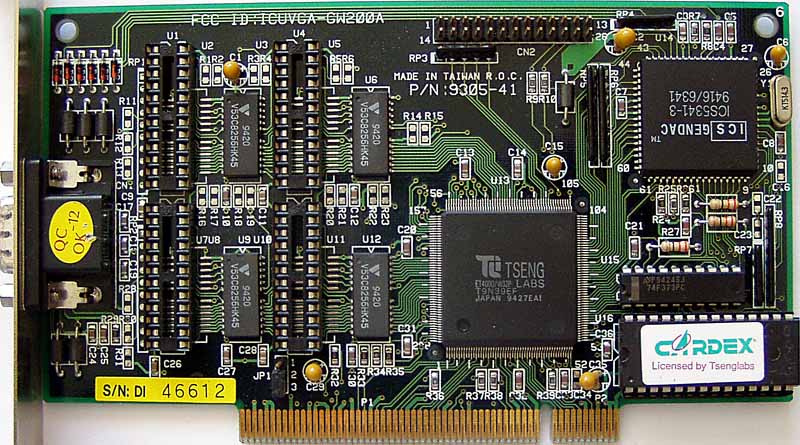 ET4000/W32
ET4000/W32
Launched: 1992
Bus: ISA
Chipset: ET4000W32
Memory Size:
1 MB DRAM (70ns)
Memory Interface: 32-bit
RAMDAC: Winbond W82C490-80
RAMDAC Speed: 80 MHz
FCC ID: HRGVGA9212
Known BIOS Dates: 01/07/93
Known BIOS Versions: v8.00
The Tseng Labs ET4000/W32 accelerator controller was an ISA/EISA/MCA compatible graphics chip delivering an 8-/16-/32-bit bus or CPU direct (local bus) interface. It was a Graphics User Interface (GUI) engine with numerous advanced features for the developing imaging and multimedia markets. The host interface was the second generation of Tseng Labs' cache/memory management architecture, and had a bandwidth that was approximately three times greater than its predecessor, the ET4000AX. A unique feature of ET4000 architecture was that the design maximized the capabilities of DRAM, and eliminated the requirement for VRAM.
These new ET4000s accelerators were the culmination of over three years' research and development. The ET4000 series of chips was designed to enhance the performance of Graphical User Interface applications, such as Microsoft Windows, by providing accelerated functions including: full 256 Raster Operation support; full cursor support (providing a second simultaneous display window); Imaging Port; memory-to-memory BLTs with masking; Pixel Amplification; line draw; and 32-bit local bus support. In addition, the W32 provided advanced memory management features such as linear addressing, Multiport Cache, and an overall bandwidth of over 91 MB/sec. An important new feature, the IMA (Image Memory Access) port is most useful for applications such as live video decompression and bit-map intensive applications such as true-color that require maximum bandwidth to the display memory.
W32 was similar to ET4000AX, but with a 32-bit windows graphics acceleration. It was Tseng's first VESA Local Bus-based card, though it was later released in PCI form also.
Linear memory mode is supported on all ET4000W32i and ET4000W32p cards, but not on the ET4000W32.
Found on the following:
- MachSpeed VGA GUI 2400S
More Images
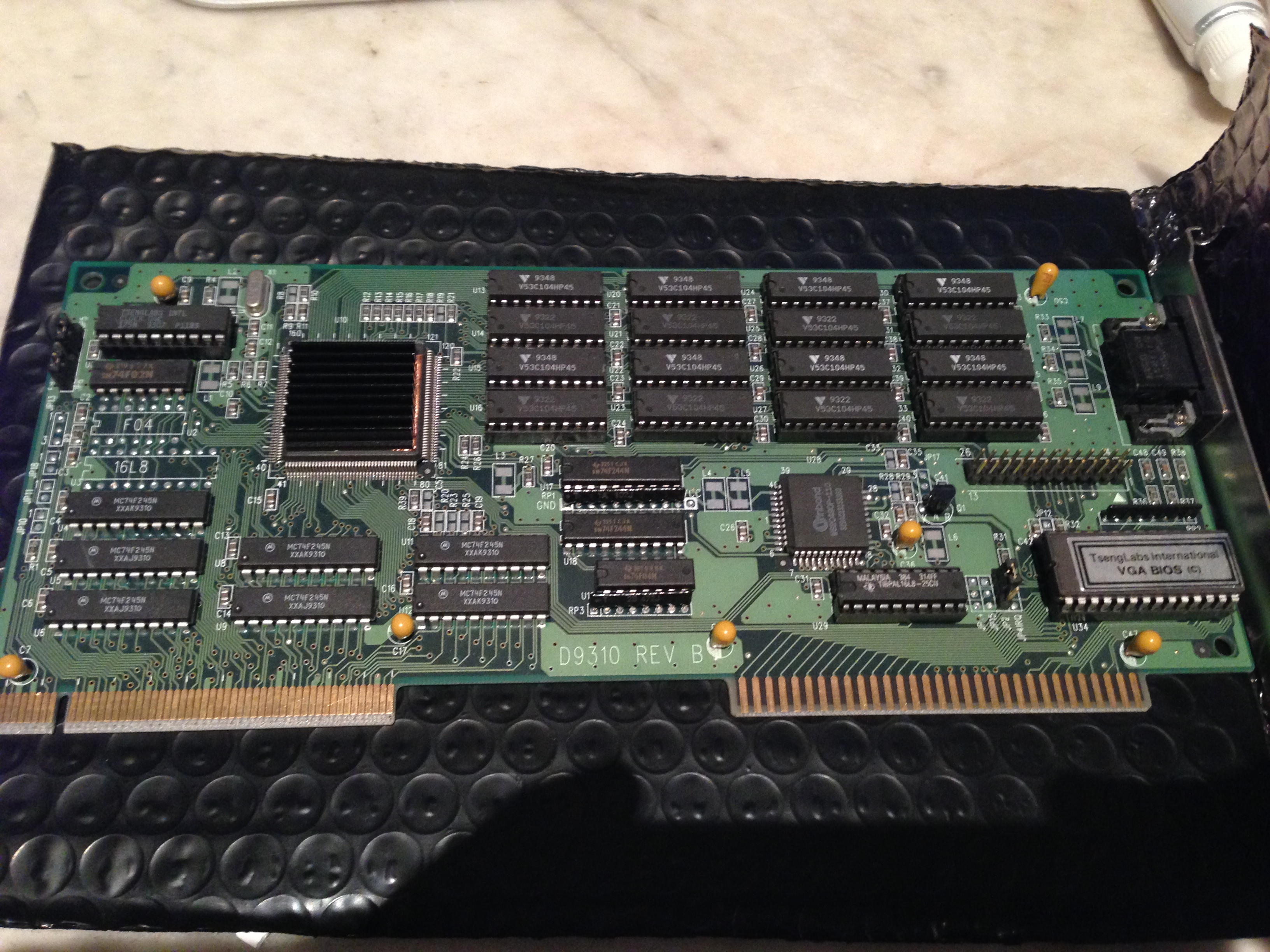 ET4000/W32i
ET4000/W32i
Launched: 1992
Bus: ISA or VESA Local Bus
Chipset: ET4000W32
Windows demanded more power from the graphic accelerator. Hence, the W32i and the W32p were introduced to provide additional performance, resolution and color, and higher levels of integration to reduce system chip count and cost. The W32i was the direct replacement for the W32 on OEM designs. The W32p delivered the memory interface of the W32i with the direct connection of PCI local bus architecture--an emerging industry standard. Both the W32i and the W32p enhanced graphic systems performance by using an approach known as memory interleaving, which doubled the graphics processing power of the device. The original W32p chip provided a 32-bit path between the graphics controller and its memory. The W32i and W32p used interleaving to effectively double the path to 64-bits, with only a minimum incremental cost to deliver the enhanced performance. In addition, the W32i and W32p could process 64-bits of graphic data in the same time that the original W32 could process 32-bits of graphic data.
- The ET4000/W32i uses memory interleaving to create a virtual 64-bit memory path. The W32i interleaved mode increases typical DRAM bandwidth by more than 170 percent of previous controllers. This bandwidth optimizes accelerator performance even in the most demanding high-resolution/high-refresh modes.
- Speeds common graphics routines such as BitBLT, area fill, font expansion, all 256 raster operations, horizontal and vertical lines, and other necessary functions.
- Interfaces easily to the VESA VL-Bus, ISA, EISA, and MCA.
- 32-bit, 0-wait state Local Bus Architecture.
- The W32i supports 512 kilobyte, one megabyte, and two megabyte configurations.
- 50 MHz system (memory) clock speed, ideally matched to -60 and -70 DRAM chips.
- Maximum pixel clock speed is 80 MHz.
- Image Memory Access port (IMA) allows motion video direct access into the single video DRAM buffer at rates of up to 40 megabytes per second.
- Multiport CacheTM, enhanced from the Tseng Labs W32, allows video DRAM to simultaneously serve multiple masters such as the IMA, CPU, and Accelerator. Each seperate master is allowed to perform as though it were the only demand on the DRAM.
- 160-pin QFP is pin compatible with the Tseng Labs ET4000/W32 accelerator.
- Supports traditional VGA RAMDACs, HiColor/True Color DACs, or XGA DAC.
- A 64x64x2 hardware can be displayed from off-screen graphics memory.
- Display modes of 1280x1024, 256 colors; 1024x768, 65,536; and 640x480, 16.8 million colors are supported.
- Hardware cursor can be expanded to a second full-screen display window (CRTCB) that is mode-independent of the primary display window.
- CRTCB can be viewed at 65,536 colors, while primary CRTC is set to 256 color mode enabling a high color full motion Window, overlayed on top of a high performance graphics application.
- Provides full ET4000/AX and ET4000/W32 software compatibility.
- Provides 32-bit linear addressing, ideal for future graphical environment software, is provided.
Similar to ET4000W32, but with support for interleaved DRAM when configured with 2MB. DRAM interleaving provided roughly 85% of the throughput of a true 64-bit interface.
Supported RAMDAC chips for /W32i include ICS5341, STG170x and Chrontel CH8398.
Found on the following:
- MachSpeed VGA GUI 2400+
- Hercules Dynamite Pro
- Colorgraphic Super Warp (PC-602105-R6)
Click here for the datasheet.
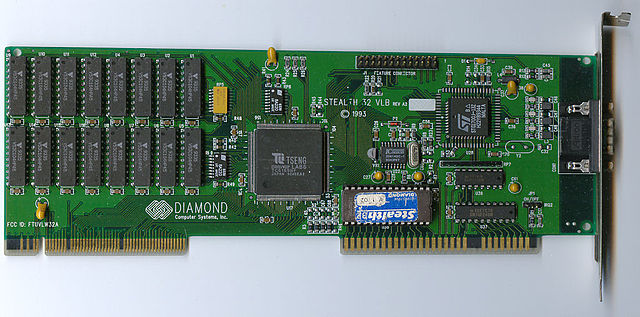 ET4000/W32p
ET4000/W32p
Launched: 1992
Bus: ISA or VESA Local Bus
Chipset: ET4000W32
Memory Interface: 64-bit
Windows demanded more power from the graphic accelerator. Hence, the W32i and the W32p were introduced to provide additional performance, resolution and color, and higher levels of integration to reduce system chip count and cost. The W32i was the direct replacement for the W32 on OEM designs. The W32p delivered the memory interface of the W32i with the direct connection of PCI local bus architecture--an emerging industry standard. Both the W32i and the W32p enhanced graphic systems performance by using an approach known as memory interleaving, which doubled the graphics processing power of the device.
- A single 208-pin graphics SVGA graphics controller with a powerful graphics accelerator.
- Glueless connection to the Peripheral Component Interconnect (PCI) bus architecture. Connection to the VESA VL-Bus can be designed with no additional interface chips.
- Resolutions of up to: 1280x1024, 256 colors, non-interlaced. 1024x768, 65,536 colors, non-interlaced. 800x600, 16.8 Million colors, non-interlaced.
- The ET4000/W32p uses video memory interleaving to achieve maximum performance at an affordable price. When interleaving is enabled, the DRAM bandwidth of the W32p increases by 70%, allowing maximum performance of the accelerator even when the display is set to demanding high-resolution / high-refresh modes.
- A powerful graphics accelerator to increase BitBLT, color expansion, text/font expansion, fill operations (both solid and pattern), and other functions used in Graphical User Interface (GUI) software such as Microsoft Windowsä.
- A powerful new programmable line drawing engine to speed CAD applications.
- The W32p controller supports one or two megabytes of video DRAM. The second megabyte creates increased graphics performance and increased color in high resolution display modes.
- A high-speed IMA port, which allows bandwidth-intensive data sources that cannot be transmitted across the ISA or EISA bus. IMA creates the most efficient access for video data intothe graphics memory. The W32p IMA is compatible with the ET4000/W32 IMA, and the Tseng Labs Video Image ProcEssoR (VIPER) chip.
- The maximum SCLK (memory or system clock) is 50 MHz, ideal for common -60 and -70 DRAM chips.
- The W32p supports traditional VGA DACs, HiColor/True Color DACs, the XGA DAC, or new 16-bit DAC chips for the widest variety of design options.
- 32-bit linear addressing can be used for simplified device driver development for GUI applications like Microsoft Windows NT, NeXT Step and others.
- A 64x64x2 color hardware cursor that is displayed from the off-screen graphics memory.
- A secondary hardware overlay window (CRTCB) for simultaneous display of graphics, or even full motion (30 frames per second) digital video.
- Multiple independent color depths may be displayed on a per-pixel basis between the primary and CRTCB hardware windows when using new 16-bit DAC chips.
- Full ET4000/AX SVGA and W32, and W32i compatibility is included. All drivers and utilities for the ET4000/AX, W32, and W32i are executable on the W32p.
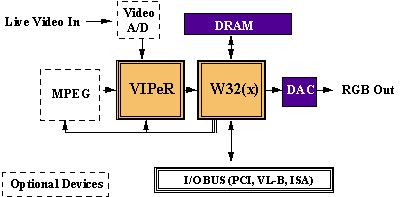
The original W32p chip provided a 32-bit path between the graphics controller and its memory. The W32i and W32p used interleaving to effectively double the path to 64-bits, with only a minimum incremental cost to deliver the enhanced performance. In addition, the W32i and W32p could process 64-bits of graphic data in the same time that the original W32 could process 32-bits of graphic data.
Similar to ET4000W32i, but with support for PCI.
Some W32p board implementations are limited to 1 MB of video memory in linear memory modes. This is a hardware limitation that cannot be solved by changing the driver. Cards with a RAMDAC that is not yet supported will be limited in a similar manner as the older cards, i.e. to a maximum pixel clock of 86 MHz, whilst they actually might be able to go up to 135 MHz. As a result, 1280x1024 modes will only be possible when using interlacing, and non-interlaced modes are limited to about 1024x768 at 75 Hz refresh.
For a non-interlaced 1280x1024x(256 colors) at say 135-MHz on a W32-type card, you need a w32p (with its 16-bit RAMDAC bus) with a multiplexing RAMDAC so that the w32p sees only (135/2 = 67.5) MHz, not 135 MHz. This requires special code only provided for cards using the ICS5341 GENDAC, the STG170x or the CH8398. This code seems to work fine for most people, except, with the ICS5341, for a small band of frequencies around 90MHz.
Found on the following:
- Hercules Dynamite Pro
- STB Lightspeed 50/50
- Diamond Stealth 32
Click here for the datasheet.
 VIPeR / VIPeR f/x
VIPeR / VIPeR f/x
Launched: 1992
Bus: PCI
Price: ?
In 1992, Tseng Labs introduced the Video Image Processor, or VIPeR to the ET4000/W32 family of chips. The VIPeR delivered the features necessary to transform a graphics adapter into a fully functional video adapter. It was designed to enhance both live video streams from sources such as a commercial camcorder or VCR, or digital motion video retrieved from a hardware or software compression/decompression engine (CODEC) such as Intel Indeo or Microsoft Video for Windows Video1ä used in .AVI files. The VIPeR intelligently sized and scaled data to make it appear larger or smaller on screen without stealing bandwidth from the CPU. The VIPeR architecture provided numerous benefits to the designer, including optimal use of the IMA port of the Tseng Labs W32 family of graphics chips and easy connection to compression hardware.
The VIPeR f/x improved upon the original VIPeR innovations, providing hardware assists required by video software applications, game applications, Microsoft Windows, Windows 95, IBM OS/2 and others. VIPeR f/x excelled in video applications, such as playing motion video files, enlarging or reducing MPEG movies and games, capturing real time video, or viewing broadcast TV in a window. The VIPeR also accepted either RGB or YUV data.
ET6000
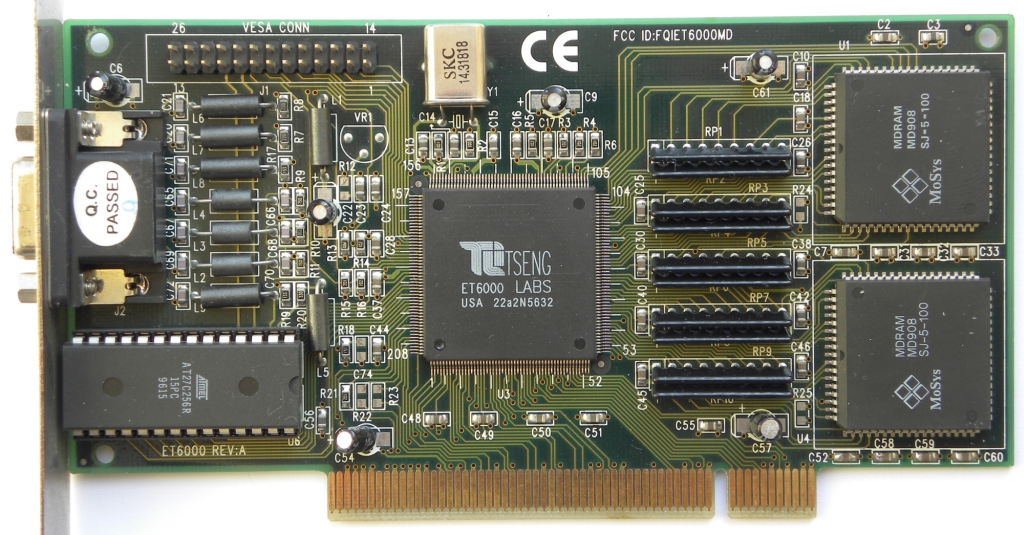 Launched: November 1995
Launched: November 1995
Bus: PCI
Memory Size: 2 MB or 4 MB MDRAM
Memory Interface: 128-bit
Memory Clock: 92 MHz
Core Clock: 135 MHz
Price: ?
In November 1995, Tseng Labs introduced the ET6000 during Fall Comdex, where it was awarded the Best of Comdex in the Sound and Display category. The ET6000 was a state-of-the-art 128-bit graphics and multimedia engine that integrated a high quality video processor, a revolutionary interface to Multibank DRAM (MDRAM), and a PCI bus interface. Optimized for Windows 95 graphics performance, the ET6000 offered high resolution and color without system degradation, delivering increased video performance and speed, higher resolution, and greater bandwidth between the graphics chip and graphics memory. The ET6000 would also continue Tseng Labs' trend of integrating technologies by bringing two important circuits--the RAMDAC and clock generators--inside a single chip.
64-bit graphics acceleration with 2 or 4 MB of MDRAM. Integrates RAMDAC into the graphics core. Core clocked at 135 MHz, 128-bit internal, 92 MHz memory frequency, 500 MB/s memory transfer speed.
For DOS, ET6000 cannot do "mode x" properly, so breaks compatibility with a few games like Jazz Jackrabbit.
"CyberMax Chooses Tseng Labs' ET6000™ Graphics and Video Controller for Max and ProMax Series PCs
Newtown, PA. — Oct. 9, 1996 — Tseng Labs, Inc. [NASDAQ: TSNG] announced today that CyberMax Computer, Inc. has selected Tseng's 128-bit ET6000 accelerator for its entire line of 166 and 200 MHz systems based on Intel Pentium, Pentium Pro, and Cyrix 6x86 microprocessors. CyberMax has adopted STB Systems, Inc.'s LIGHTSPEED 128 as the standard graphics adapter for premier members of the company's Max and ProMax series PCs. Based on the ET6000, STB's LIGHTSPEED 128 is one of the first product introductions using Tseng Labs' revolutionary new technology.
Touted as "the ultimate Windows 95® DirectX engine," the ET6000 delivers unmatched graphics performance, video scaling quality, and a patented Display List Processor. The accelerator garnered the coveted Best of Comdex award during its unveiling last fall.
"We chose the ET6000 based on its superb Windows95 graphics capabilities, high quality video playback, and outstanding game performance," said Tony Renaldi, CyberMax marketing director. "It's the fastest graphics chip we've ever tested." Systems featuring the ET6000 are available from CyberMax today.
"CyberMax has traditionally excelled at meeting the needs of power users in today's small and home office environments," said Jim Bauer, senior vice president of sales and marketing for Tseng Labs, Inc. "The ET6000's unmatched graphics performance and powerful multimedia processor coupled with Multibank DRAM delivers the bandwidth those users demand to accelerate today's video and 3D enabled business and entertainment applications."
Highlights of the ET6000 include the following:
• 128-bit graphics acceleration
• Unsurpassed support for Microsoft's DirectX and Windows 95
• "Better-than-TV" quality video playback
• Simultaneous display of multiple scaled video windows
Tseng Labs ET6000 has won industry recognition and awards for its innovative design and its performance. Products featuring the ET6000 are available from companies including STB Systems, Hercules Computer Graphics, Videologic, and Jazz Multimedia among other companies."
Mark Karsch, Senior VP and CFO, Tseng Labs, 9th October 1996
Supported resolutions:
| Color Depth | 640 x 480 | 800 x 600 | 1024 x 768 | 1152 x 864 | 1280 x 1024 | 1600 x 1200 |
| 8-bit (256 Colors) | 60 - 85 Hz | 56 - 85 Hz | 43 - 85 Hz | 60 - 75 Hz | 43 - 75 Hz | 43 Hz |
| 16-bit (65K Colors) | 60 - 85 Hz | 56 - 85 Hz | 43 - 85 Hz | 60 - 75 Hz | 43 - 60 Hz** | |
| 24-bit (16.7M Colors) | 60 - 85 Hz | 56 - 85 Hz | 43 - 75 Hz* | 60 Hz |
*Requires 2.5 MB MDRAM, **Requires 3 MB MDRAM
Cards the used the ET6000 include:
- STB Lightspeed 128
 VPR6000
VPR6000
Launched: 1996
Bus: PCI
Price: ?
The VPR6000 was introduced to complement the ET6000 chip's internal video processing engine and to reduce the required components for multimedia video applications. The VPR6000 was a video image processor that enabled live video input and allowed ISA and other multimedia devices to reside on the Company's proprietary Image Memory Access (IMA) multimedia bus. The device was designed to allow OEMs to create feature-rich, highly integrated, PCI compliant, low cost multimedia solutions.
"Tseng Labs Announces ET6000 Selected by Compaq For New PC Theatre
ET6000 and VPR6000� Power New Entertainment PC
NEWTOWN, Pa. (May 1, 1997) Tseng Labs, Inc. (NASDAQ:TSNG) today revealed that its ET6000 graphics and multimedia engine and VPR6000 video processor were chosen by Compaq Computer Corporation for its recently announced PC Theatre 9000.
"Compaq's PC Theatre 9000 family represents a new category of consumer entertainment devices that delivers TV broadcasts merged with traditional high performance PC capabilities on a large screen display," said Monty McGraw, Director Hardware Engineering, Consumer Emerging Markets at Compaq. "Tseng Labs' display technology enables the high quality imaging and robust multimedia feature set critical to establishing PC Theatre 9000 as a leader in the entertainment PC category."
The award-winning ET6000 and VPR6000 are ideally suited to the demands of next generation PC/TV solutions. High quality scaling and de-interlacing of live TV deliver crisp images for full screen or windowed displays. Tseng's proven Multi-Port Cache manages multiple high bandwidth data streams to ensure that the incoming TV images suffer no loss of video data, even in high-resolution display modes. In contrast, many competitive solutions strip data from the incoming video signal, resulting in reduced image quality or dropped frames. The ET6000 and VPR6000 enable high quality PC/TV products like Compaq's PC Theatre 9000 that use broadcast TV technology to deliver Internet data, traditional TV programming and interactive entertainment services that blend the two.
Compaq's PC Theatre 9000 is based on Intel's 200MHz Pentium® processor with MMX technology and features a 36" big-screen multimedia monitor, full screen de-interlaced TV display, picture-in-picture, closed caption decoder, stereo surround sound and infrared wireless remote control with integrated trackball and mouse. PC Theatre 9000 is available at Circuit City and Comp USA in select launch cities.
Tseng's ET6000 and VPR6000 are also included in Microsoft's hardware platform reference design for the recently announced Broadcast PC architecture. Microsoft unveiled their digital broadcasting strategy at the National Association of Broadcasters conference (NAB '97) on April 6, including plans to deliver DirectX API extensions with future versions of the Windows95 and Windows/NT operating systems. Microsoft also delivered a limited release SDK (system design kit) in February to Tseng and other partners for the development of technologies and services combining the PC, broadcast television, and the Internet. Tseng Labs customers interested in delivering Broadcast PC solutions featuring the ET6000 family of 2D and 3D accelerators should contact their Tseng Labs representative for more information."
Mitch Paris, Tseng Labs, 1st May 1997
ET6100
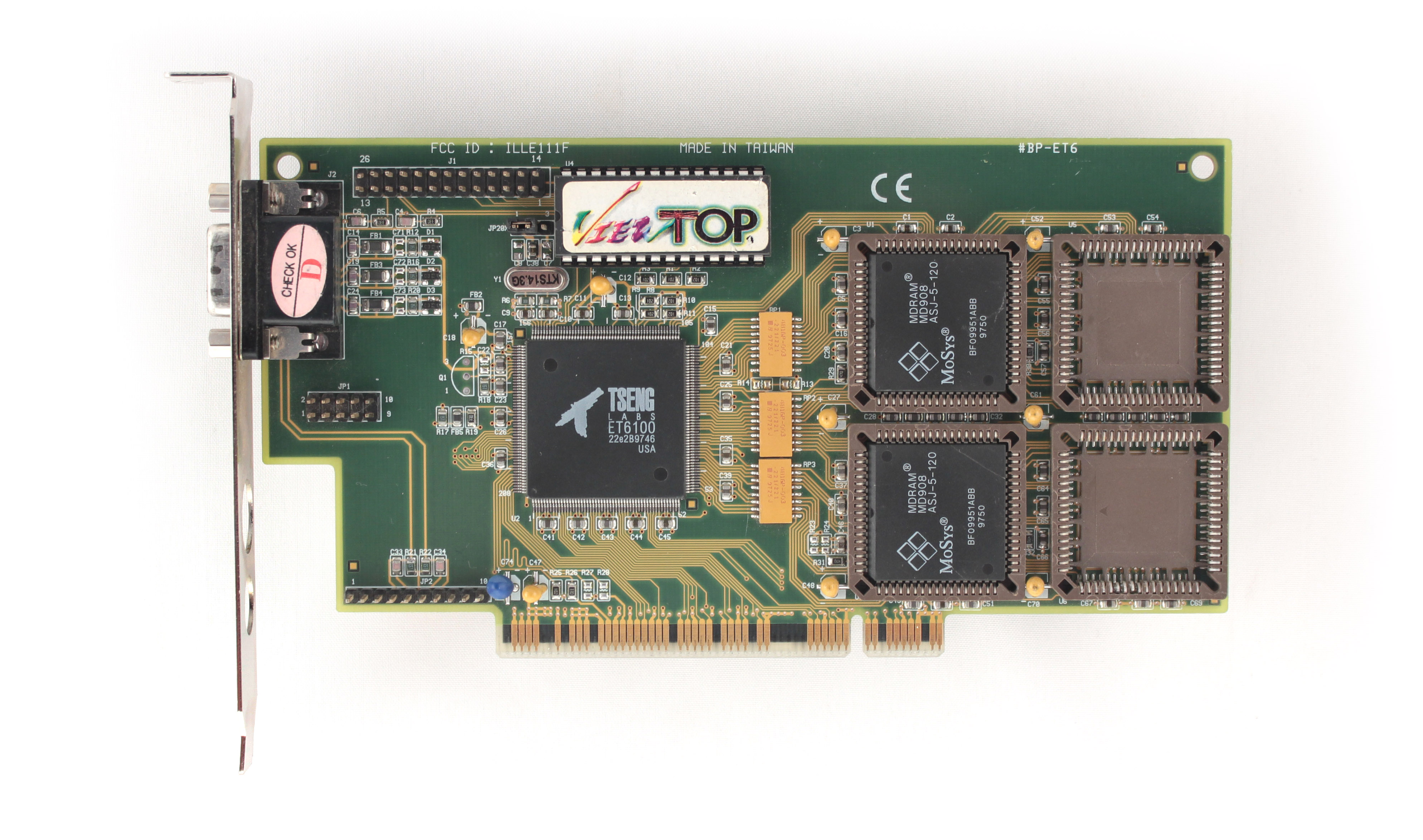 Launched: 1997
Launched: 1997
Bus: PCI
Memory Interface: 128-bit
Core Clock: 175 MHz
Price: ?
Tseng Labs' ET6100 was an enhanced, pin-compatible version of the 128-bit ET6000 2D Graphics and Multimedia Engine. The ET6100 featured an integrated 175MHz VGA-compatible LUT-DAC (Look-Up Table Digital-to-Analogue Converter) and delivers increased display bandwidth to support additional high resolution modes. These new modes include:
- 1280 x 1024 16-bit at 75Hz
- 1024 x 768 24-bit at 85Hz
- 1600 x 1200 in 8 and 16-bit pixel depths
Improved the integrated RAMDAC of the ET6000 to address problems with blurriness at higher resolutions. Uses faster MDRAM (Multibank DRAM).
"Newtown, PA. Tseng Labs, Inc. [NASDAQ: TSNG] today announced the availability of the ET6100, an enhanced version of its 128-bit ET6000 2D Graphics and Multimedia Engine. The ET6100 features an integrated 175Hz VGA-compatible LUT-DAC and delivers increased display bandwidth to support additional high resolution modes. These new modes include 1280x1024 16-bit at 75Hz, 1024x768 24-bit at 85 Hz and 1600x1200 in 8 and 16-bit pixel depths.
The ET6100 was demonstrated at the recent Computex trade show in Taiwan, and is targeted at feature-rich entertainment solutions using Tseng's companion VPR6100 Video Processor or a high-performance, dedicated 3D processor such as the PowerVR from NEC Electronics. The recently announced Apocolypse 5D from Videologic features the ET6100 and the PowerVR PCX2 to generate an unbeatable combination of Windows 95, DOS and Direct3D� performance for today's demanding business applications and advanced 3D game titles.
"Many of the current crop of combination graphics cards force the end user to compromise between good 2D/poor 3D and average 3D/poor 2D," said Kevin Dale, vice president of sales and marketing for Videologic Multimedia Systems. "The Apocolypse 5D delivers outstanding performance in both 2D and 3D, and for the first time gives users a combo solution without compromise."
Tseng currently offers OEM reference designs based on the ET6100 and VPR6100 that provide TV-in-a-window with on-board TV tuner and TV-out capabilities using a discrete PAL/NTSC encoder, and is working with third parties to create turn-key solutions offering additional features such as high-quality DVD playback and Broadcast PC support.
The ET6100 provides high quality scaling and de-interlacing of broadcast TV and DVD video streams to deliver crisp images for full screen or windowed displays. Tseng's proven Multi-Port Cache manages multiple high bandwidth data streams to ensure that the incoming TV or DVD images suffer no loss of video data, even in high-resolution display modes. A high-speed, synchronous Multibank DRAM (MDRAM) interface produces net bandwidth in excess of 500 Mbytes/sec to handle even the most demanding applications. Robust DirectDraw support allows OEMs to take advantage of these features efficiently to deliver rich Windows 95 multimedia solutions supporting Microsoft's Simply Interactive PC (SIPC) initiative."
Mitch Paris, Tseng Labs, 17th June 1997
ET6300
Was to be Tseng's first 3D-capable chipset. Not completed before Tseng chose to sell up. No known specimens have been spotted in the wild.
"Tseng Labs Reveals 3D Graphics Roadmap Products Targeted at the Needs of Next Generation 3D Titles
NEWTOWN, PA. (November 18, 1996) Tseng Labs, Inc. (NASDAQ:TSNG) today announced its plans for a family of 3D graphics accelerators to address the expanding needs of the next generation of 3D titles.
Developed around Tseng Labs' award-winning ET6000™ 2D graphics and video accelerator, the first of the new 3D processors, called the ET6300™, enhances the industry-leading Windows 95 performance and video processing capabilities of the ET6000 while adding critical 3D features lacking in first generation 3D graphics devices.
Advances over existing 3D solutions include an integrated triangle setup engine and floating point to fixed point conversion unit to deliver improved triangle setup rates. The ET6300 supports sophisticated MIP mapped texture filtering and other advanced rendering features, as well as a proven 128-bit synchronous memory interface for greater pixel fill rates and enhanced Direct3D performance. "Based on Tseng's ET6000, the Dynamite 128/Video generates unbeatable DOS and DirectDraw performance for today's games," said John Edeleanu, president of Hercules Computer. "Advanced 3D features like triangle setup and MIP mapping will be required to power the next wave of Direct3D action titles, and the ET6300 is ideally positioned for next generation 3D platforms."
Triangle setup and floating point conversion are tasks that must be performed in software with today's 3D rendering engines. By burdening the CPU with the overhead of triangle setup, these first generation controllers reduce available cycles for other tasks and clog the PCI bus with unnecessary setup data. As games continue to grow more sophisticated and demanding, today's controllers have created an unbalanced system that limits overall performance.
"By integrating triangle setup and transparency effects in the ET6300, Tseng Labs is delivering a 3D engine that allows game developers to raise the bar on scene complexity and overall impact of next generation titles," noted David Chait, Vice President of Product Design at Reality Bytes. "Basing advanced 3D features around the ET6000 core should mean solid DirectX performance for demanding D3D titles like Dark Vengeance."
By integrating these critical features the ET6300 eliminates up to 50% of the CPU workload, freeing valuable cycles for improved software audio and video decoding, faster I/O response and increased frame rates. Eliminating the need to transfer setup data for each triangle increases useable PCI bandwidth to boost triangle rates for today's titles. Removing this transfer overhead allows next generation games to model scenes using many smaller triangles for greater geometric fidelity and depth of field. Balancing the 3D tasks more efficiently between CPU and graphics accelerator allows the ET6300 to offer higher performance and improved 3D realism to high performance game and entertainment titles of today and tomorrow.
"The GrafixStar 600 continues to deliver industry leading Windows 95 performance and video quality for feature-rich multimedia and entertainment titles," said Jordan Watters, vice president of sales and marketing at Videologic. "By integrating a floating point converter and triangle set up engine around the ET6000's proven feature set, the ET6300 will provide dramatically improved 3D performance."
Tseng expects to be one of the first mainstream graphics supplier to deliver advanced rendering capabilities with an integrated triangle setup engine and high-speed synchronous memory to the market. Limited engineering samples to alpha customers are expected late in the fourth quarter. Production units will be manufactured using a state-of-the-art 0.35 micron, 3.3V process. Tseng is planning to introduce the ET6300 in early 1997. Additional 3D plans for 1997 also include support for Intel's Advanced Graphics Port (AGP) standard."
Mitch Paris, Tseng Labs, 18th November 1996
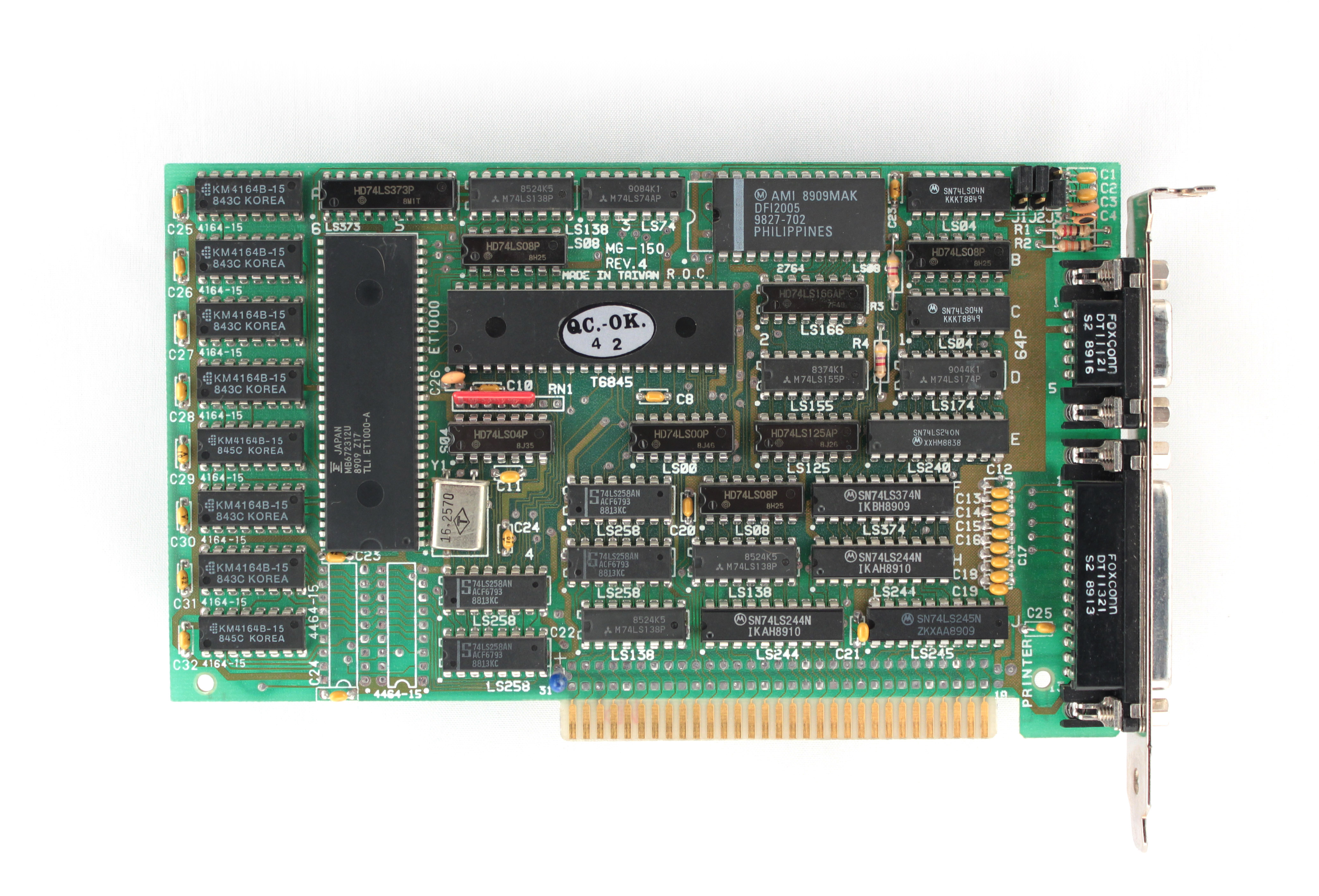
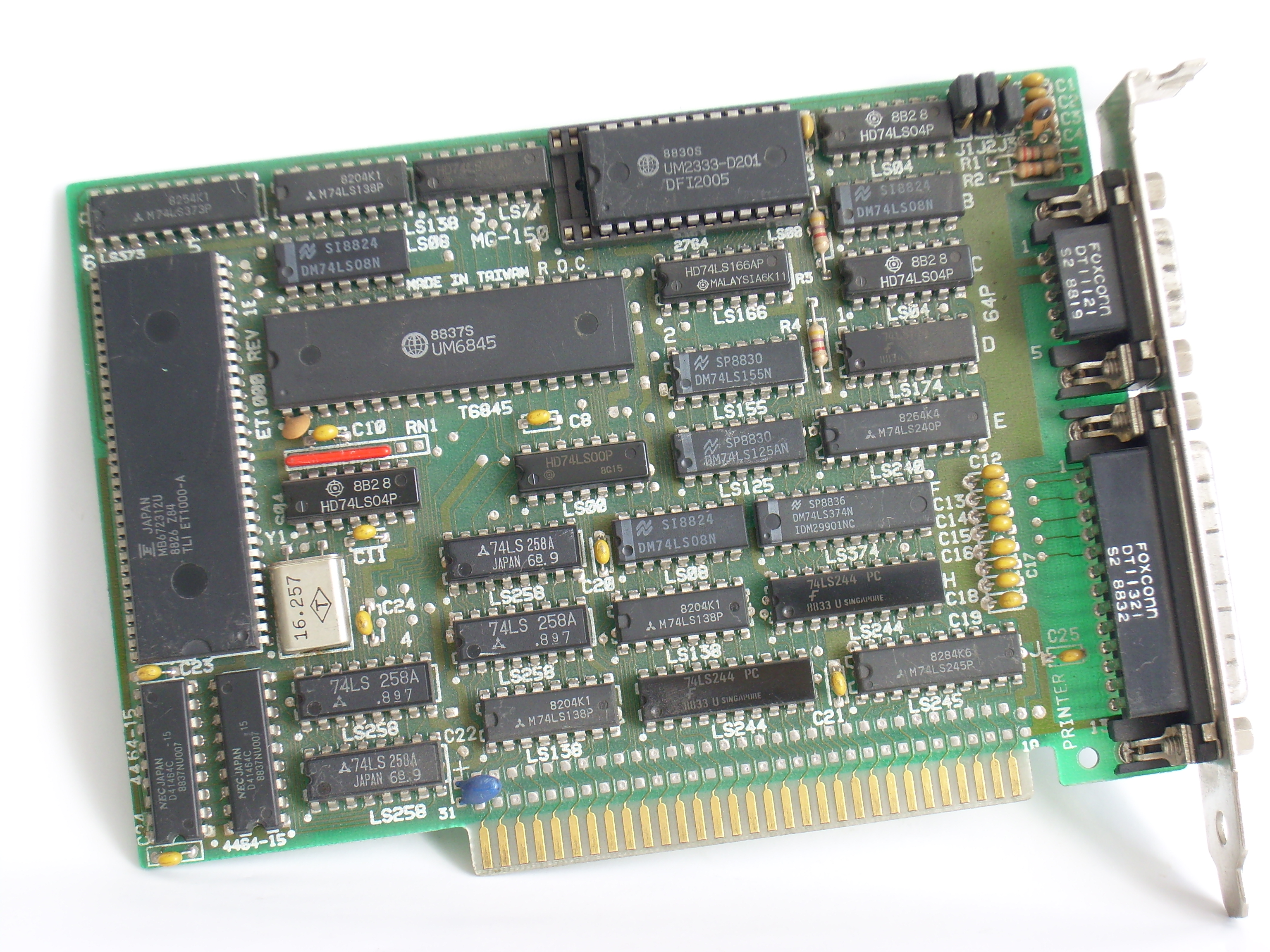
.jpg)
.jpg)
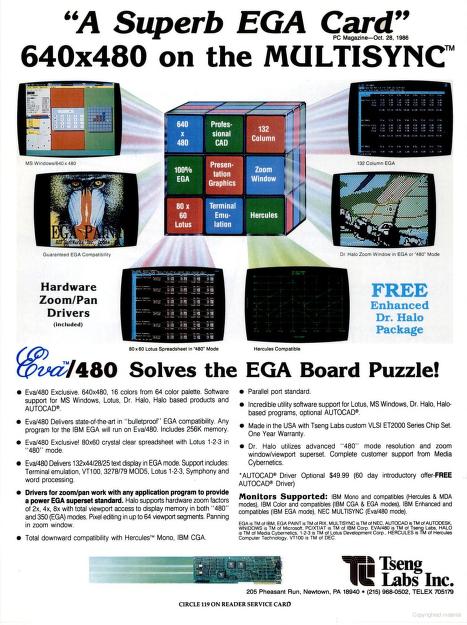
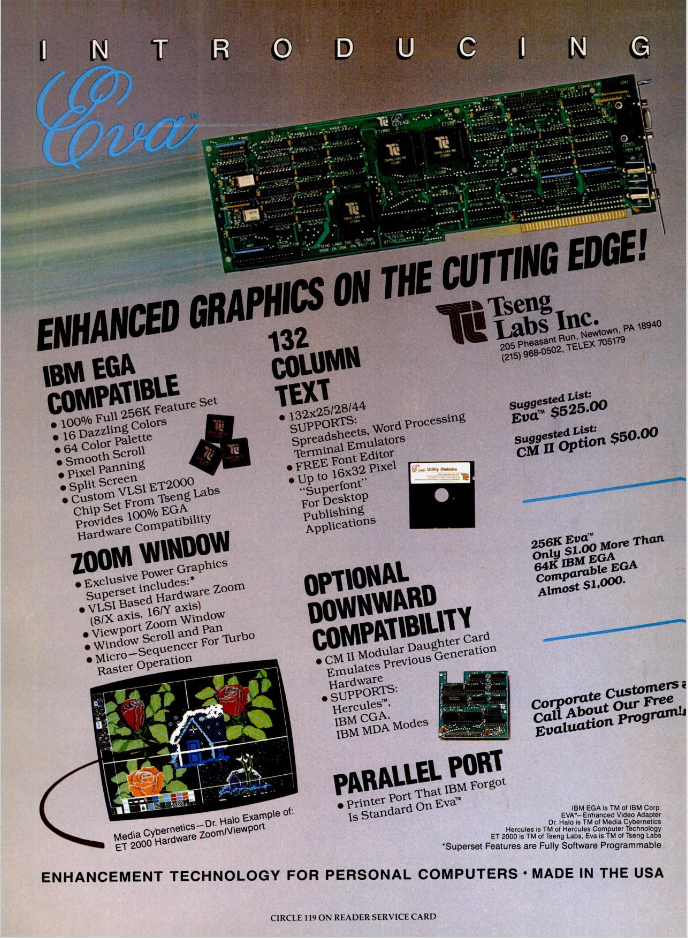
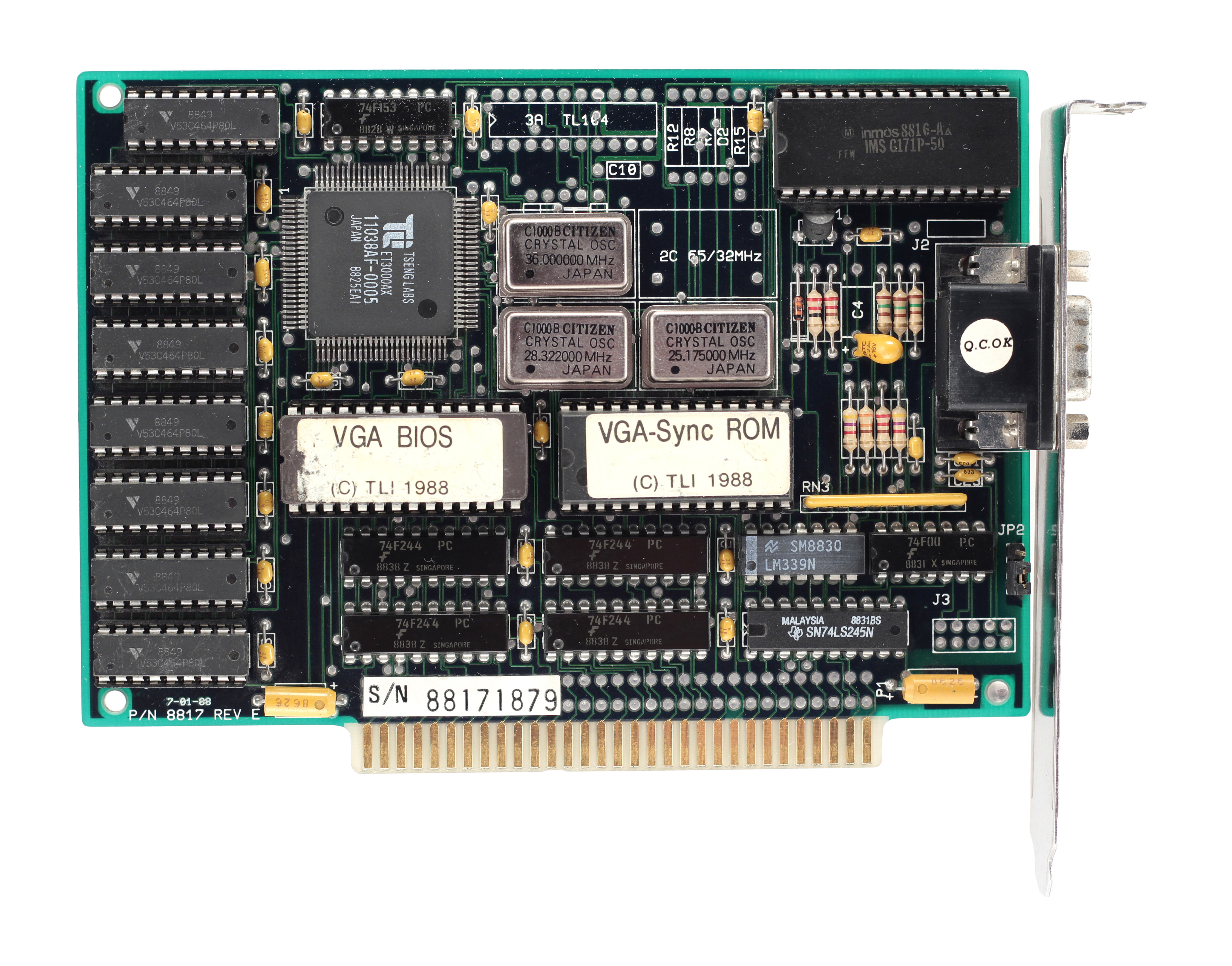
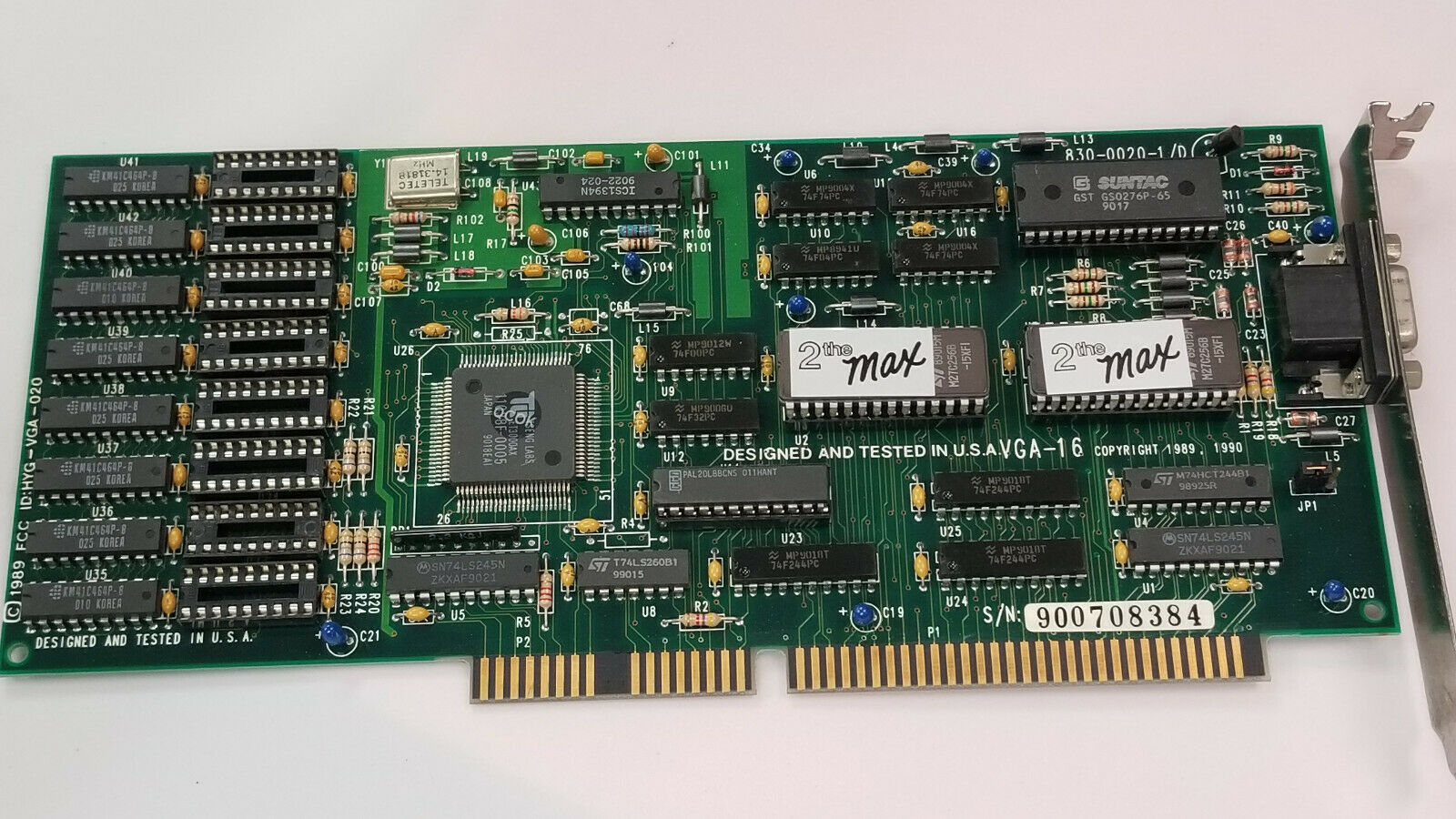
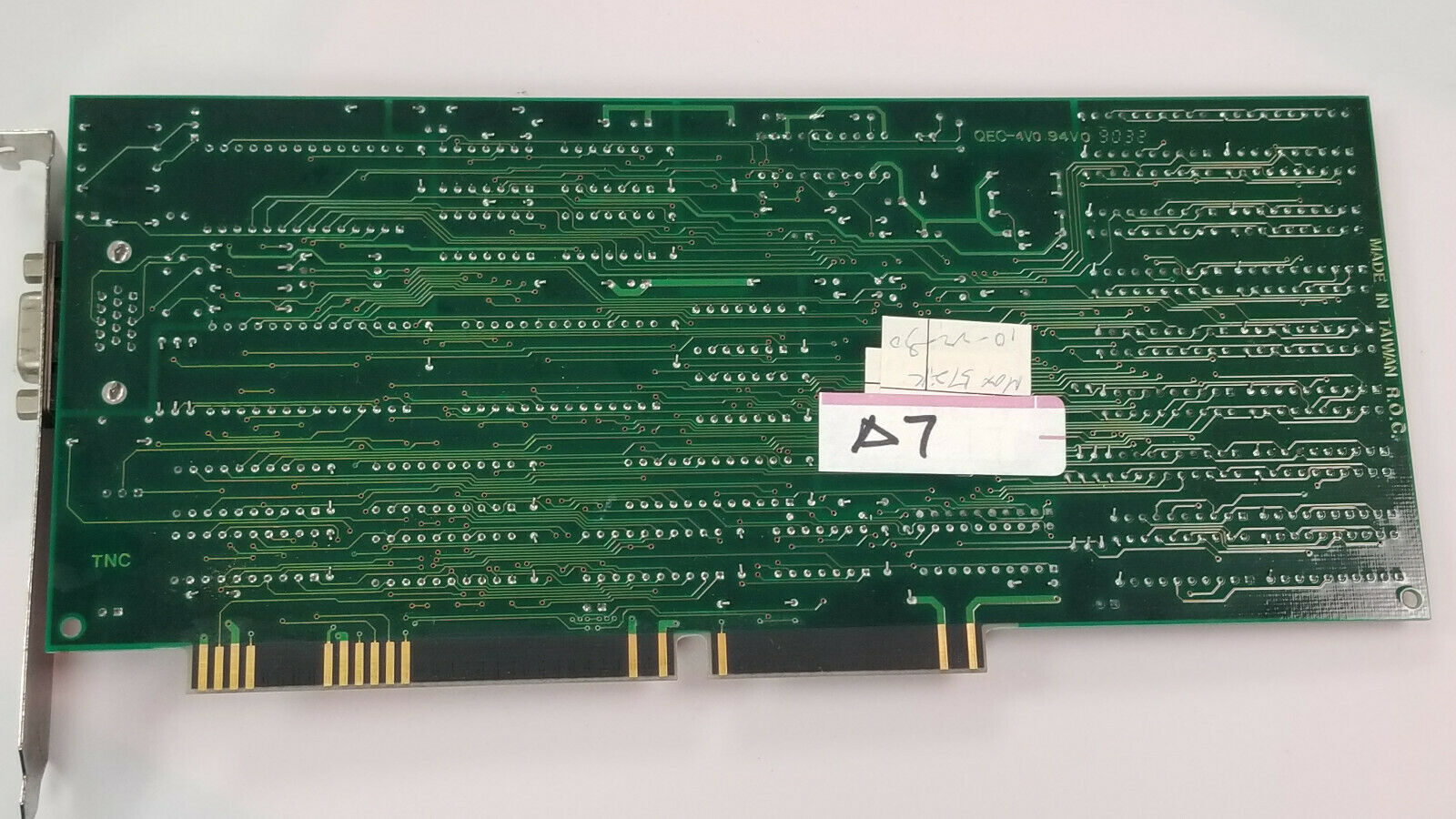
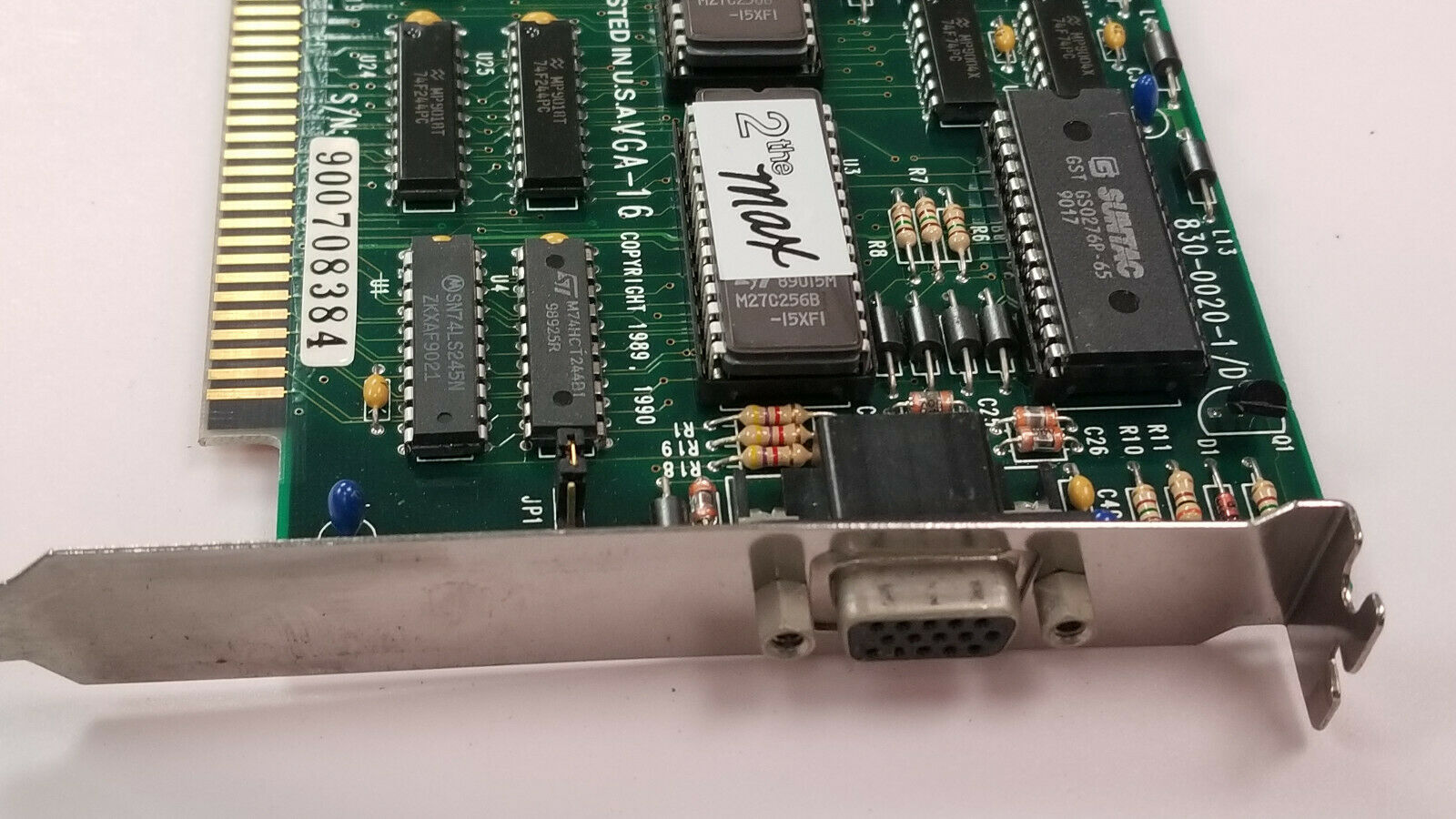
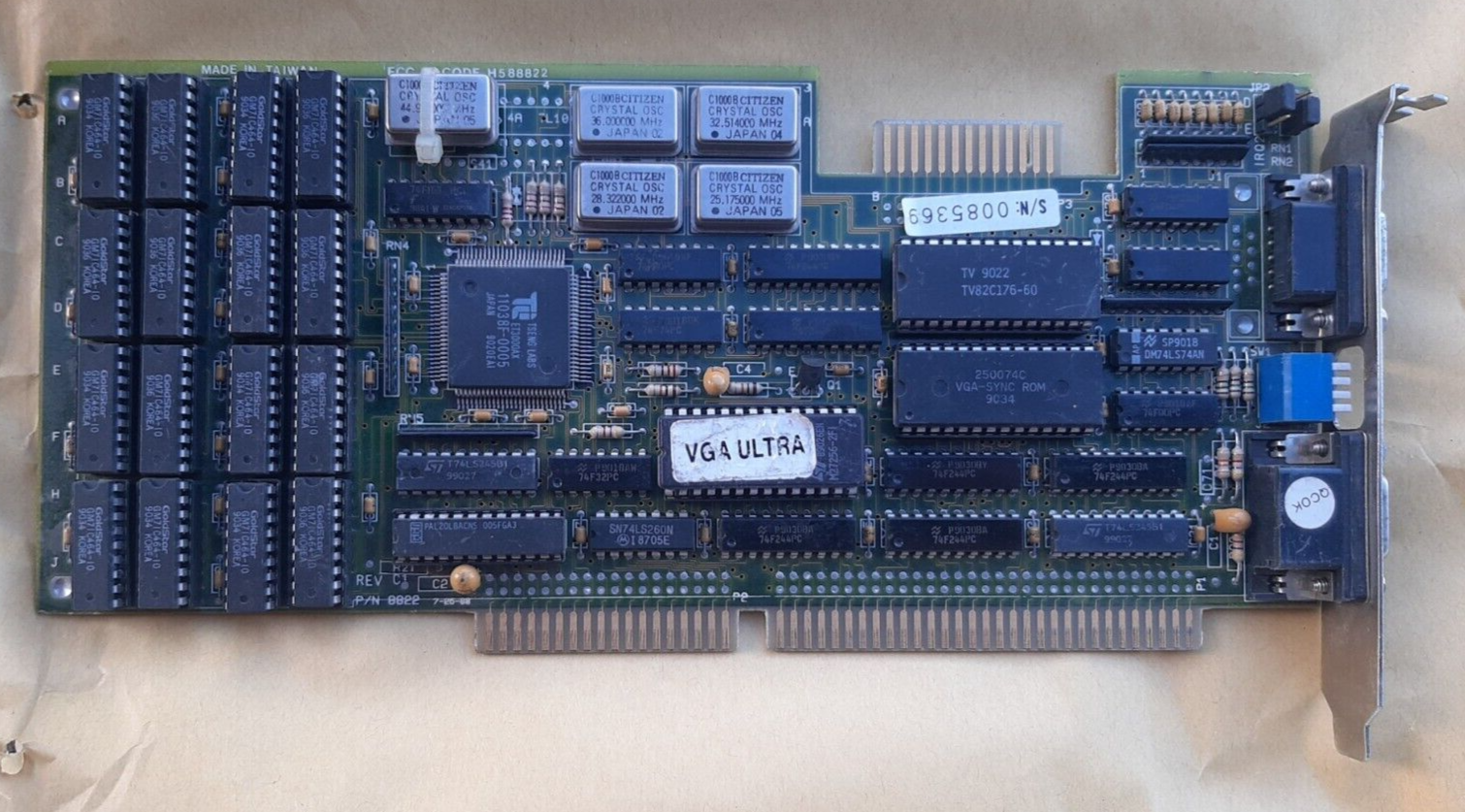
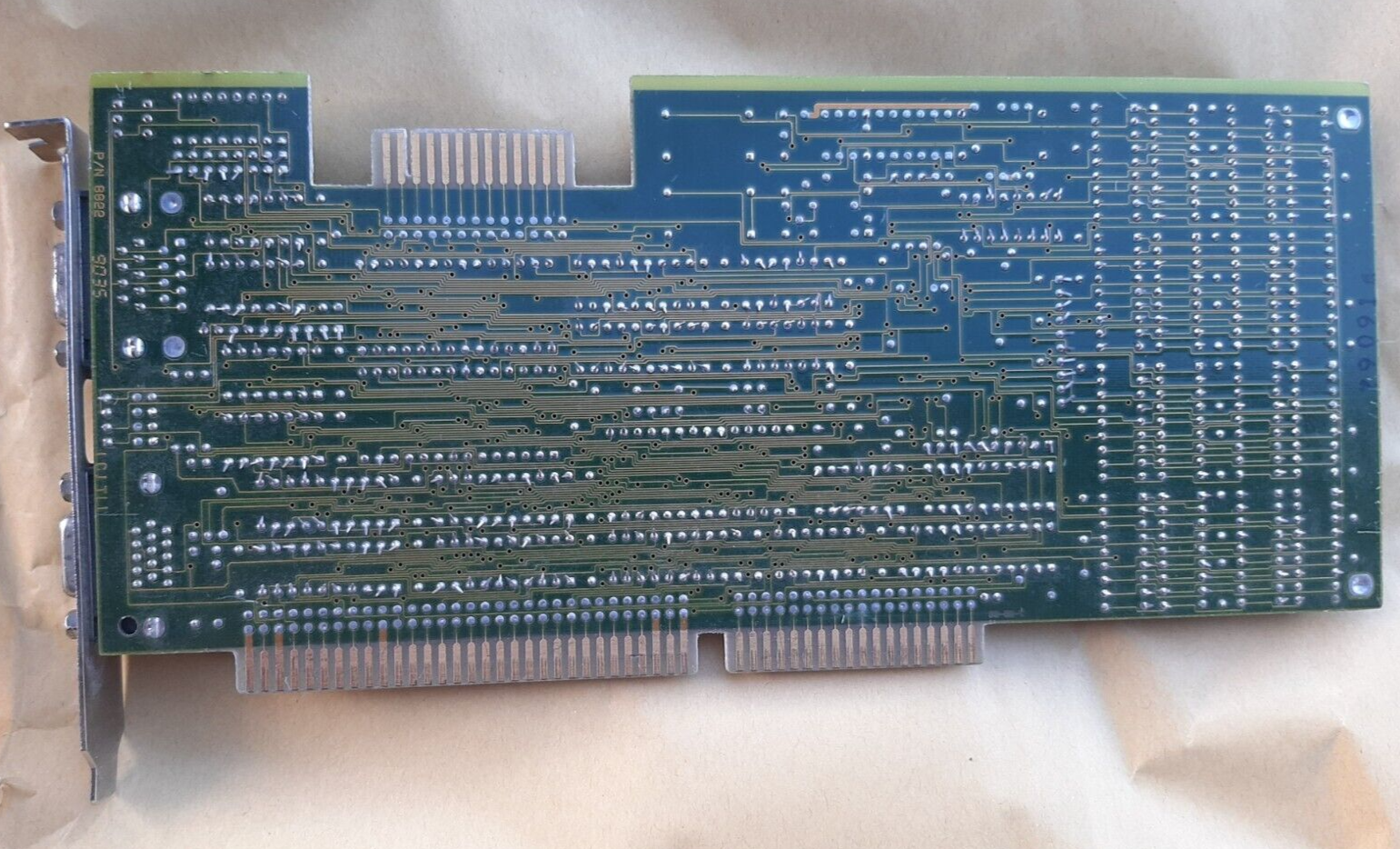
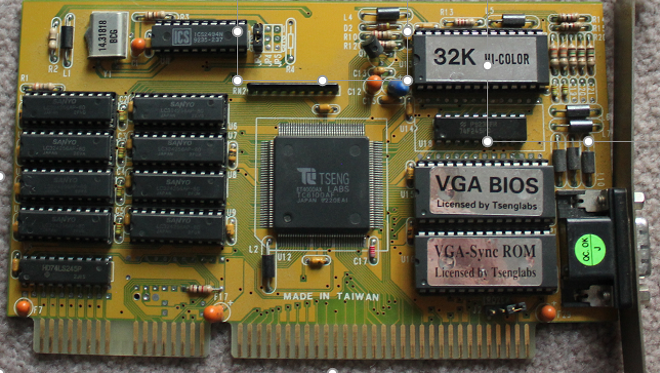
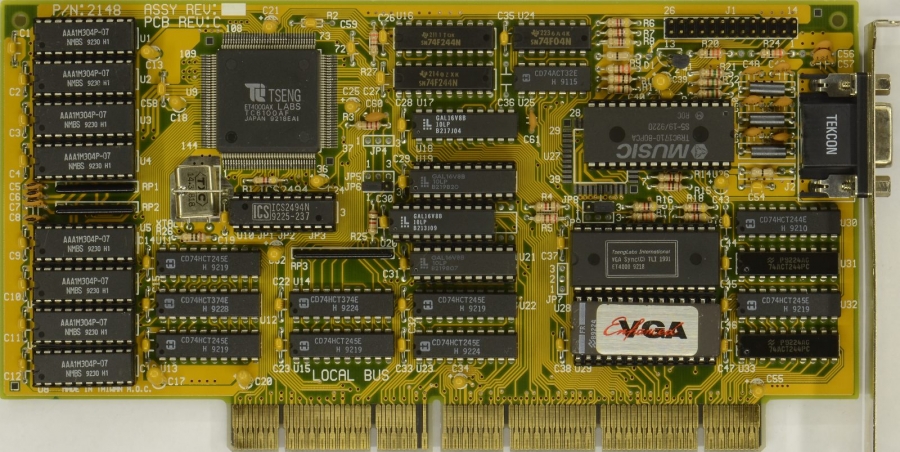
.jpg)
.jpg)
